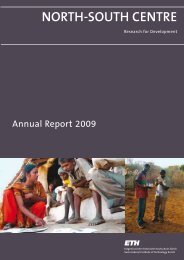Annual Report 2006/07 - ETH - North-South Centre North-South ...
Annual Report 2006/07 - ETH - North-South Centre North-South ...
Annual Report 2006/07 - ETH - North-South Centre North-South ...
You also want an ePaper? Increase the reach of your titles
YUMPU automatically turns print PDFs into web optimized ePapers that Google loves.
ZIL research projectsLivestocksystemsresearchAnimal production and healthZIL research project, Phase IVProject leaderAwudu Abdulai,Kiel University, GermanyContact personEmily Awuor OumaCollaboratorsAdam Drucker, ILRI /Charles Darwin University, AustraliaDurationOctober 2003 – May 20<strong>07</strong>Developing optimised cattle breeding schemes, with aspecial focus on trypanotolerance, based on the demands andopportunities of poor livestock-keepers – Economic aspectsIn spite of the crucial role livestock plays in the economies ofmany sub-Saharan African countries, livestock productivityremains relatively low in the region due to several constraints.Demand-driven breed improvement programmesserve as natural entry points for productivity increases, especiallyin areas plagued by diseases such as trypanosomiasis.This study evaluates cattle-keepers’ preferences for cattletraits, which could be used in designing breeding schemes,by using a choice experiment survey of 508 households inKenya and Ethiopia. Mixed logit and latent class models areemployed to empirically model preference behaviour. Theresults reveal significant heterogeneity in preferences mainlybased on the production systems under which cattle husbandrytakes place. For instance, traction potential is a highlyvalued trait among livestock owners in cropping systems,while fertility and reproduction ability are highly valued inthe pastoral systems, reflecting the different cattle-keepingobjectives between production systems. These findingsreveal the importance of distinguishing differences in preferencesbetween population segments as it provides aframework for adapting breeding policy interventions tospecific segments.Livestock grazing in a crop-livestock production system in Lambwe valley inEthiopia (one of the project study areas)The study also investigates pathways by which cattle-keeperscan access improved breeds based on their traits of preference.The use of artificial insemination is limited in therural areas due to inadequate infrastructure. An alternativepathway is through communal breeding bull initiatives. Abinary logit model has been employed to investigate factorsthat influence an individual’s choice to take up collectiveaction decisions through communal based initiatives. Theresults show that resource-poor households with no accessto off-farm income have a higher probability of participatingin collective action initiatives. This implies that an importantpathway for poor cattle keepers to access improved breeds isby means of community-based breeding initiatives.36
















